China's Transition Economy and HRM Practices
VerifiedAdded on 2023/04/11
|7
|1174
|405
AI Summary
This article discusses the challenges and strategies for HRM practices in China's transition economy. It explores topics such as selection, training, appraisal, reward systems, retention, and socializing. The cultural context and the need for modification in HRM practices are also highlighted.
Contribute Materials
Your contribution can guide someone’s learning journey. Share your
documents today.
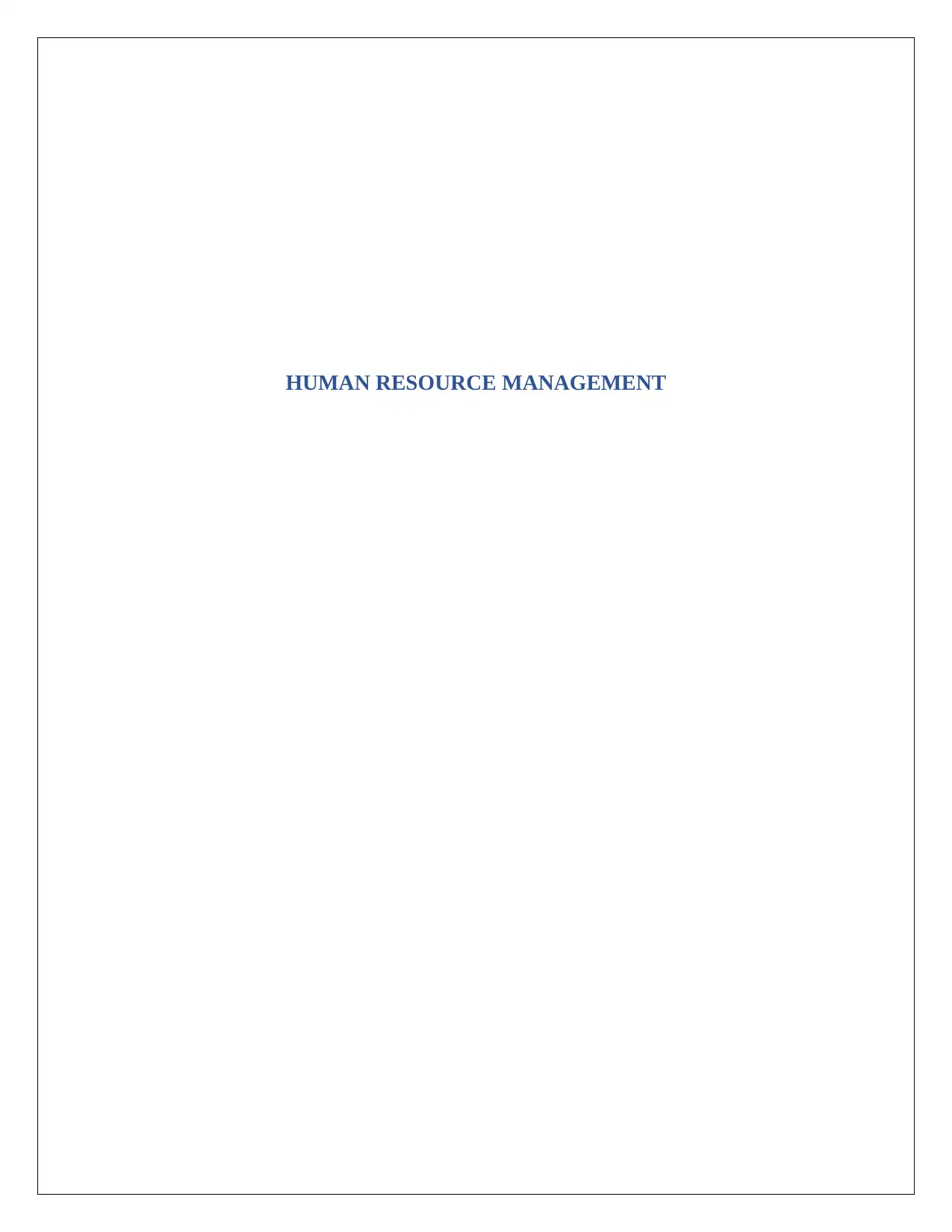
HUMAN RESOURCE MANAGEMENT
Secure Best Marks with AI Grader
Need help grading? Try our AI Grader for instant feedback on your assignments.
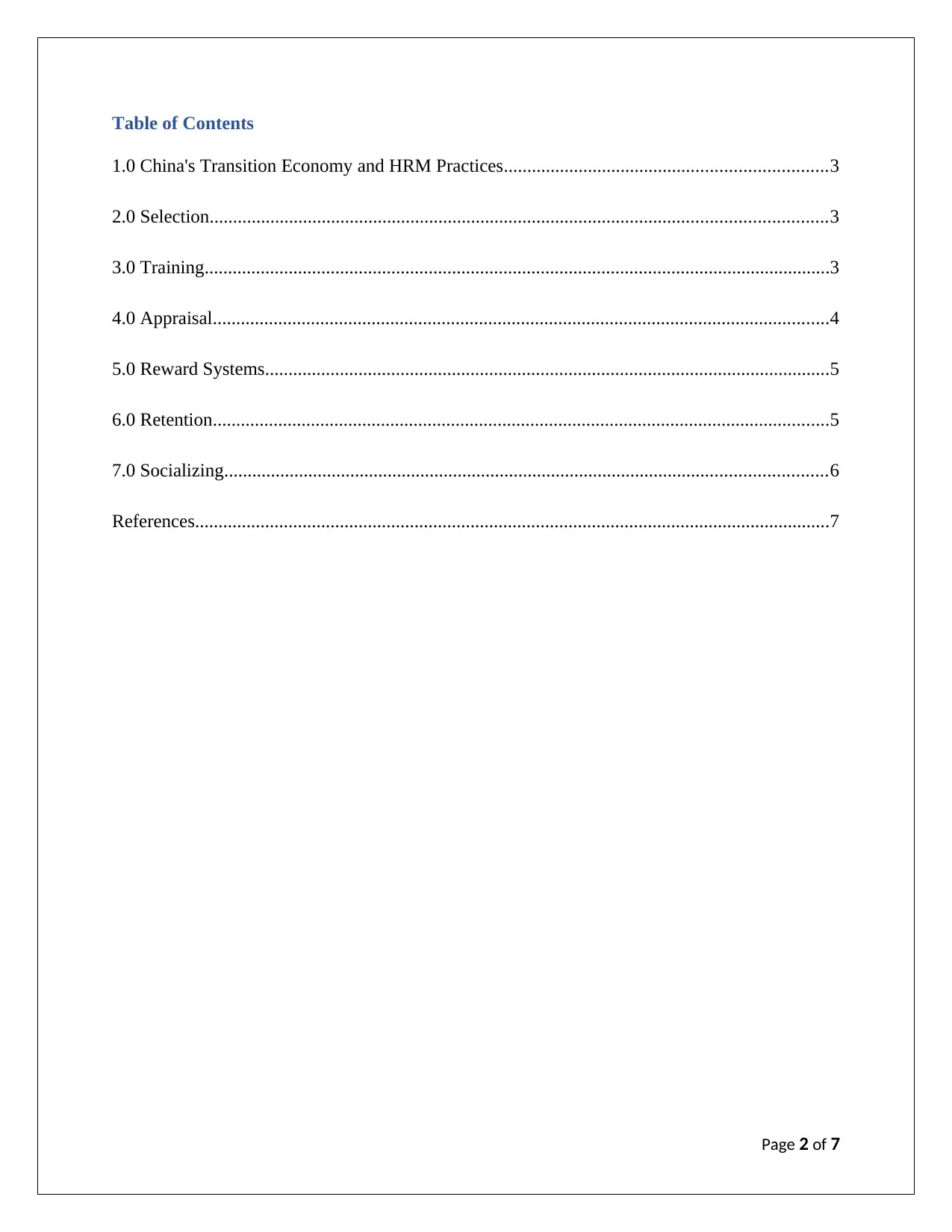
Table of Contents
1.0 China's Transition Economy and HRM Practices.....................................................................3
2.0 Selection....................................................................................................................................3
3.0 Training......................................................................................................................................3
4.0 Appraisal....................................................................................................................................4
5.0 Reward Systems.........................................................................................................................5
6.0 Retention....................................................................................................................................5
7.0 Socializing.................................................................................................................................6
References........................................................................................................................................7
Page 2 of 7
1.0 China's Transition Economy and HRM Practices.....................................................................3
2.0 Selection....................................................................................................................................3
3.0 Training......................................................................................................................................3
4.0 Appraisal....................................................................................................................................4
5.0 Reward Systems.........................................................................................................................5
6.0 Retention....................................................................................................................................5
7.0 Socializing.................................................................................................................................6
References........................................................................................................................................7
Page 2 of 7
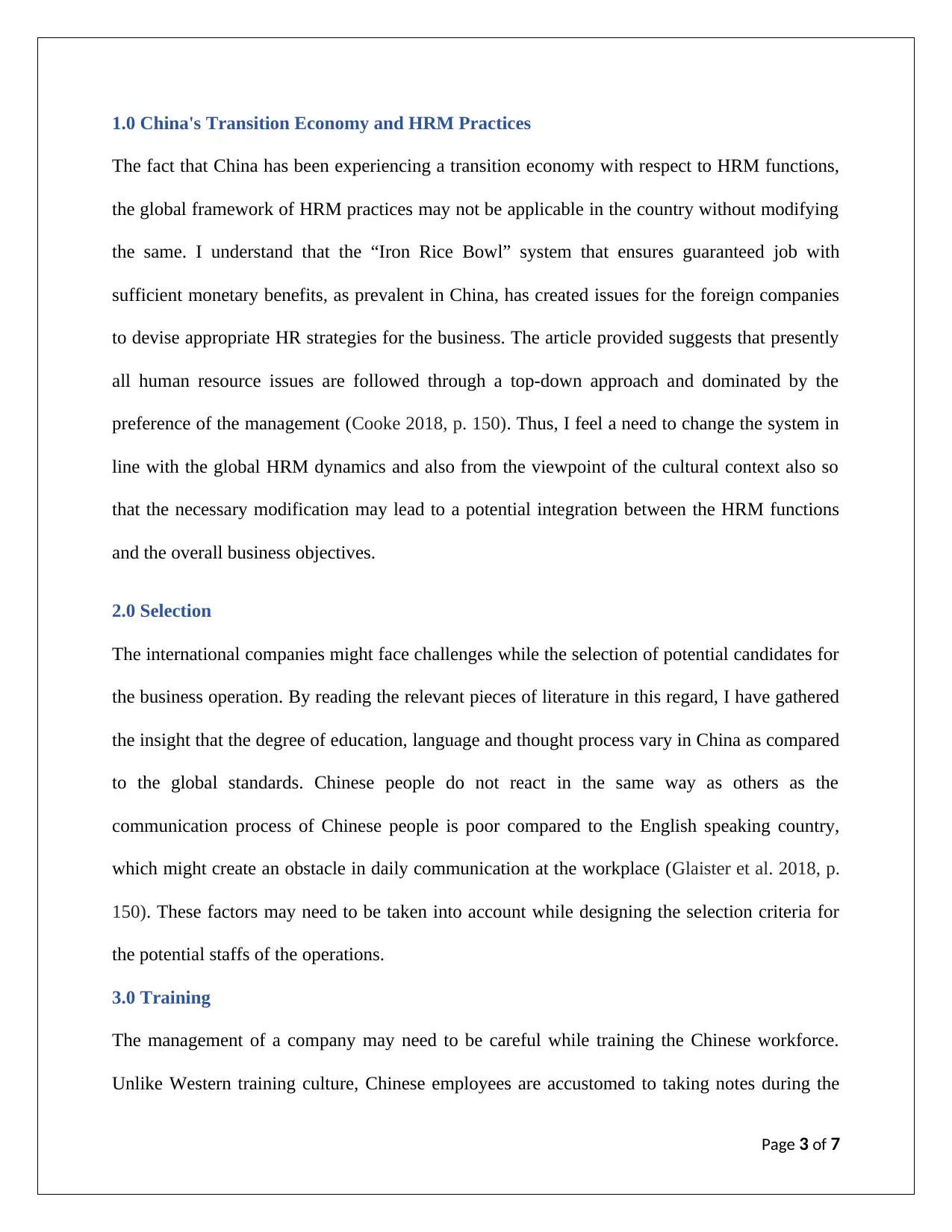
1.0 China's Transition Economy and HRM Practices
The fact that China has been experiencing a transition economy with respect to HRM functions,
the global framework of HRM practices may not be applicable in the country without modifying
the same. I understand that the “Iron Rice Bowl” system that ensures guaranteed job with
sufficient monetary benefits, as prevalent in China, has created issues for the foreign companies
to devise appropriate HR strategies for the business. The article provided suggests that presently
all human resource issues are followed through a top-down approach and dominated by the
preference of the management (Cooke 2018, p. 150). Thus, I feel a need to change the system in
line with the global HRM dynamics and also from the viewpoint of the cultural context also so
that the necessary modification may lead to a potential integration between the HRM functions
and the overall business objectives.
2.0 Selection
The international companies might face challenges while the selection of potential candidates for
the business operation. By reading the relevant pieces of literature in this regard, I have gathered
the insight that the degree of education, language and thought process vary in China as compared
to the global standards. Chinese people do not react in the same way as others as the
communication process of Chinese people is poor compared to the English speaking country,
which might create an obstacle in daily communication at the workplace (Glaister et al. 2018, p.
150). These factors may need to be taken into account while designing the selection criteria for
the potential staffs of the operations.
3.0 Training
The management of a company may need to be careful while training the Chinese workforce.
Unlike Western training culture, Chinese employees are accustomed to taking notes during the
Page 3 of 7
The fact that China has been experiencing a transition economy with respect to HRM functions,
the global framework of HRM practices may not be applicable in the country without modifying
the same. I understand that the “Iron Rice Bowl” system that ensures guaranteed job with
sufficient monetary benefits, as prevalent in China, has created issues for the foreign companies
to devise appropriate HR strategies for the business. The article provided suggests that presently
all human resource issues are followed through a top-down approach and dominated by the
preference of the management (Cooke 2018, p. 150). Thus, I feel a need to change the system in
line with the global HRM dynamics and also from the viewpoint of the cultural context also so
that the necessary modification may lead to a potential integration between the HRM functions
and the overall business objectives.
2.0 Selection
The international companies might face challenges while the selection of potential candidates for
the business operation. By reading the relevant pieces of literature in this regard, I have gathered
the insight that the degree of education, language and thought process vary in China as compared
to the global standards. Chinese people do not react in the same way as others as the
communication process of Chinese people is poor compared to the English speaking country,
which might create an obstacle in daily communication at the workplace (Glaister et al. 2018, p.
150). These factors may need to be taken into account while designing the selection criteria for
the potential staffs of the operations.
3.0 Training
The management of a company may need to be careful while training the Chinese workforce.
Unlike Western training culture, Chinese employees are accustomed to taking notes during the
Page 3 of 7

training session (Radel, 2019. p. 20). In addition, the employees do not express their
understanding in class during the training session. Rather, they intend to attend smaller sized
classes and training sessions wherein they can interact with trainees. I admit that such
behavioural issue may create problem while planning the training and development session for
the Chinese workforce by the people from Western culture. In addition, I would also like to state
that the topics that need to be discussed in the sessions may be kept in chronological order so that
cause-effect and actions can be presented in sequential order.
4.0 Appraisal
Since the cultural dimension model differs in China compared to the Western countries, while
appraising the Chinese employees, the HR managers of the company may need to prioritize the
following items:
Using a non-systematic appraisals
Focusing on group appraisal rather than individual performance
Ensuring that none of the declarations would be made public to avoid ethical issues
Training local and foreign supervisors are to be trained enough to respect each other’s
cultural value
In this context, I would like to mention that appraisal is an integral part of the HRM process and
one of the most success-critical aspects of the business operations also as the motivated
employees enhance the operational excellence. However, cultural differences may accordingly
need to be mitigated in order to ensure equity and rights of the employees from a social
perspective (Cooke 2018, p. 150).
Page 4 of 7
understanding in class during the training session. Rather, they intend to attend smaller sized
classes and training sessions wherein they can interact with trainees. I admit that such
behavioural issue may create problem while planning the training and development session for
the Chinese workforce by the people from Western culture. In addition, I would also like to state
that the topics that need to be discussed in the sessions may be kept in chronological order so that
cause-effect and actions can be presented in sequential order.
4.0 Appraisal
Since the cultural dimension model differs in China compared to the Western countries, while
appraising the Chinese employees, the HR managers of the company may need to prioritize the
following items:
Using a non-systematic appraisals
Focusing on group appraisal rather than individual performance
Ensuring that none of the declarations would be made public to avoid ethical issues
Training local and foreign supervisors are to be trained enough to respect each other’s
cultural value
In this context, I would like to mention that appraisal is an integral part of the HRM process and
one of the most success-critical aspects of the business operations also as the motivated
employees enhance the operational excellence. However, cultural differences may accordingly
need to be mitigated in order to ensure equity and rights of the employees from a social
perspective (Cooke 2018, p. 150).
Page 4 of 7
Secure Best Marks with AI Grader
Need help grading? Try our AI Grader for instant feedback on your assignments.
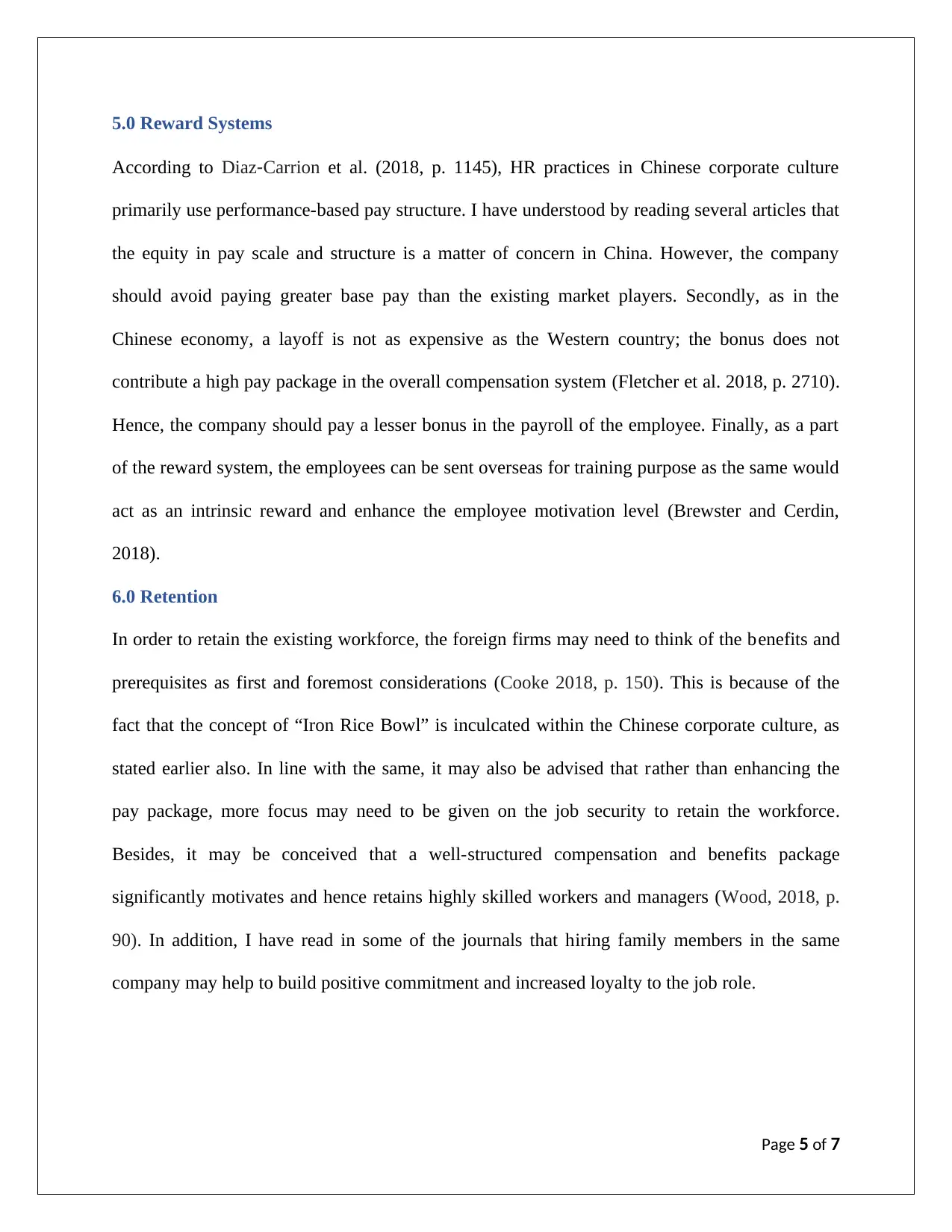
5.0 Reward Systems
According to Diaz‐Carrion et al. (2018, p. 1145), HR practices in Chinese corporate culture
primarily use performance-based pay structure. I have understood by reading several articles that
the equity in pay scale and structure is a matter of concern in China. However, the company
should avoid paying greater base pay than the existing market players. Secondly, as in the
Chinese economy, a layoff is not as expensive as the Western country; the bonus does not
contribute a high pay package in the overall compensation system (Fletcher et al. 2018, p. 2710).
Hence, the company should pay a lesser bonus in the payroll of the employee. Finally, as a part
of the reward system, the employees can be sent overseas for training purpose as the same would
act as an intrinsic reward and enhance the employee motivation level (Brewster and Cerdin,
2018).
6.0 Retention
In order to retain the existing workforce, the foreign firms may need to think of the benefits and
prerequisites as first and foremost considerations (Cooke 2018, p. 150). This is because of the
fact that the concept of “Iron Rice Bowl” is inculcated within the Chinese corporate culture, as
stated earlier also. In line with the same, it may also be advised that rather than enhancing the
pay package, more focus may need to be given on the job security to retain the workforce.
Besides, it may be conceived that a well-structured compensation and benefits package
significantly motivates and hence retains highly skilled workers and managers (Wood, 2018, p.
90). In addition, I have read in some of the journals that hiring family members in the same
company may help to build positive commitment and increased loyalty to the job role.
Page 5 of 7
According to Diaz‐Carrion et al. (2018, p. 1145), HR practices in Chinese corporate culture
primarily use performance-based pay structure. I have understood by reading several articles that
the equity in pay scale and structure is a matter of concern in China. However, the company
should avoid paying greater base pay than the existing market players. Secondly, as in the
Chinese economy, a layoff is not as expensive as the Western country; the bonus does not
contribute a high pay package in the overall compensation system (Fletcher et al. 2018, p. 2710).
Hence, the company should pay a lesser bonus in the payroll of the employee. Finally, as a part
of the reward system, the employees can be sent overseas for training purpose as the same would
act as an intrinsic reward and enhance the employee motivation level (Brewster and Cerdin,
2018).
6.0 Retention
In order to retain the existing workforce, the foreign firms may need to think of the benefits and
prerequisites as first and foremost considerations (Cooke 2018, p. 150). This is because of the
fact that the concept of “Iron Rice Bowl” is inculcated within the Chinese corporate culture, as
stated earlier also. In line with the same, it may also be advised that rather than enhancing the
pay package, more focus may need to be given on the job security to retain the workforce.
Besides, it may be conceived that a well-structured compensation and benefits package
significantly motivates and hence retains highly skilled workers and managers (Wood, 2018, p.
90). In addition, I have read in some of the journals that hiring family members in the same
company may help to build positive commitment and increased loyalty to the job role.
Page 5 of 7
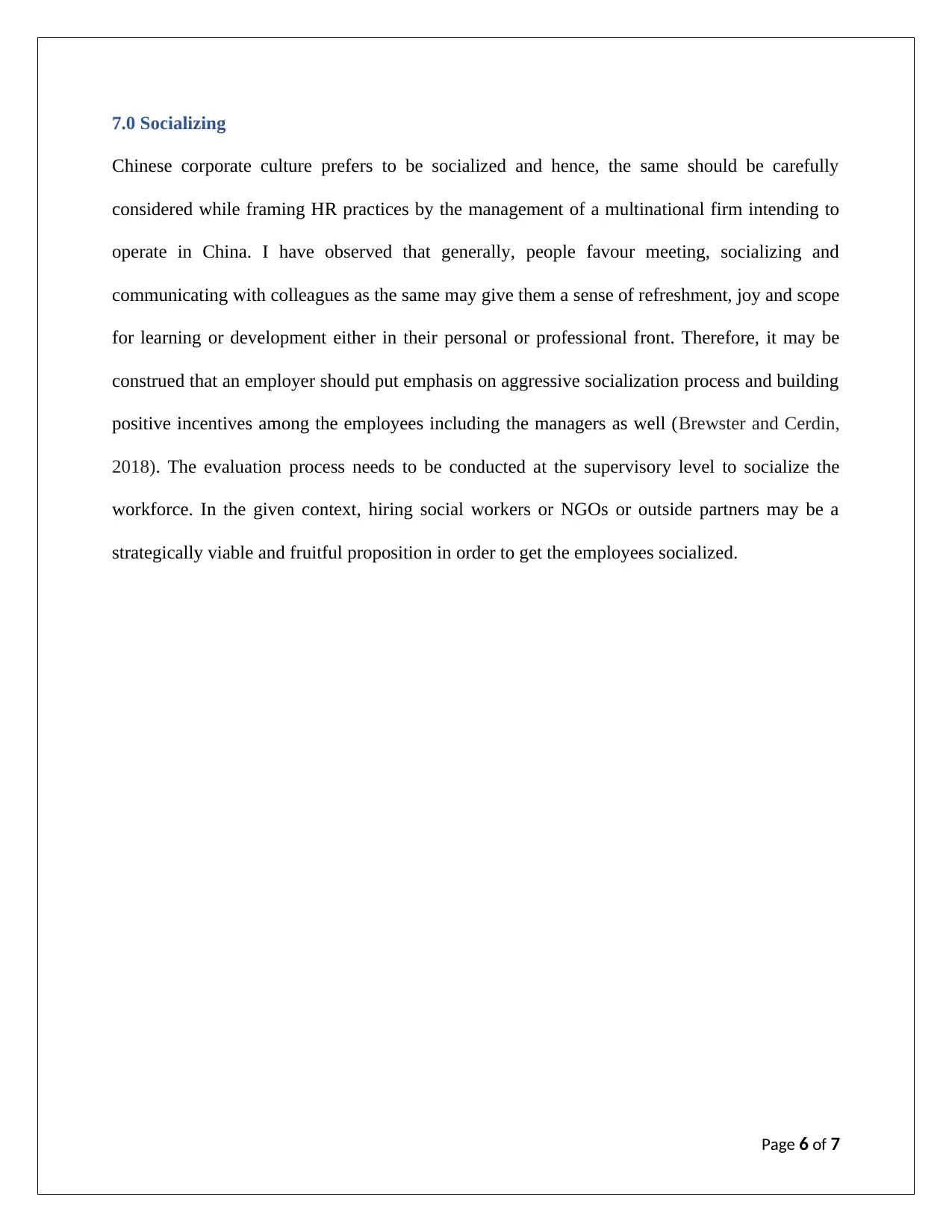
7.0 Socializing
Chinese corporate culture prefers to be socialized and hence, the same should be carefully
considered while framing HR practices by the management of a multinational firm intending to
operate in China. I have observed that generally, people favour meeting, socializing and
communicating with colleagues as the same may give them a sense of refreshment, joy and scope
for learning or development either in their personal or professional front. Therefore, it may be
construed that an employer should put emphasis on aggressive socialization process and building
positive incentives among the employees including the managers as well (Brewster and Cerdin,
2018). The evaluation process needs to be conducted at the supervisory level to socialize the
workforce. In the given context, hiring social workers or NGOs or outside partners may be a
strategically viable and fruitful proposition in order to get the employees socialized.
Page 6 of 7
Chinese corporate culture prefers to be socialized and hence, the same should be carefully
considered while framing HR practices by the management of a multinational firm intending to
operate in China. I have observed that generally, people favour meeting, socializing and
communicating with colleagues as the same may give them a sense of refreshment, joy and scope
for learning or development either in their personal or professional front. Therefore, it may be
construed that an employer should put emphasis on aggressive socialization process and building
positive incentives among the employees including the managers as well (Brewster and Cerdin,
2018). The evaluation process needs to be conducted at the supervisory level to socialize the
workforce. In the given context, hiring social workers or NGOs or outside partners may be a
strategically viable and fruitful proposition in order to get the employees socialized.
Page 6 of 7

References
Brewster, C. and Cerdin, J.L., (2018). HRM in Mission Driven Organizations.
Cooke, F.L., (2018). Organizational outsourcing and implications for HRM. In Human Resource
Management (pp. 135-155). Routledge.
Diaz‐Carrion, R., López‐Fernández, M. and Romero‐Fernandez, P.M., (2018). Developing a
sustainable HRM system from a contextual perspective. Corporate Social Responsibility and
Environmental Management, 25(6), pp.1143-1153.
Fletcher, L., Alfes, K. and Robinson, D., (2018). The relationship between perceived training and
development and employee retention: the mediating role of work attitudes. The International
Journal of Human Resource Management, 29(18), pp.2701-2728.
Glaister, A.J., Karacay, G., Demirbag, M. and Tatoglu, E., (2018). HRM and performance—The
role of talent management as a transmission mechanism in an emerging market context. Human
Resource Management Journal, 28(1), pp.148-166.
Radel, J., (2019). Human Resources Management and Human Resources
Development. Handbook of Vocational Education and Training: Developments in the Changing
World of Work, pp.1-24.
Wood, S., (2018). HRM and organizational performance. In Human Resource Management (pp.
74-97). Routledge.
Page 7 of 7
Brewster, C. and Cerdin, J.L., (2018). HRM in Mission Driven Organizations.
Cooke, F.L., (2018). Organizational outsourcing and implications for HRM. In Human Resource
Management (pp. 135-155). Routledge.
Diaz‐Carrion, R., López‐Fernández, M. and Romero‐Fernandez, P.M., (2018). Developing a
sustainable HRM system from a contextual perspective. Corporate Social Responsibility and
Environmental Management, 25(6), pp.1143-1153.
Fletcher, L., Alfes, K. and Robinson, D., (2018). The relationship between perceived training and
development and employee retention: the mediating role of work attitudes. The International
Journal of Human Resource Management, 29(18), pp.2701-2728.
Glaister, A.J., Karacay, G., Demirbag, M. and Tatoglu, E., (2018). HRM and performance—The
role of talent management as a transmission mechanism in an emerging market context. Human
Resource Management Journal, 28(1), pp.148-166.
Radel, J., (2019). Human Resources Management and Human Resources
Development. Handbook of Vocational Education and Training: Developments in the Changing
World of Work, pp.1-24.
Wood, S., (2018). HRM and organizational performance. In Human Resource Management (pp.
74-97). Routledge.
Page 7 of 7
1 out of 7
Related Documents
Your All-in-One AI-Powered Toolkit for Academic Success.
+13062052269
info@desklib.com
Available 24*7 on WhatsApp / Email
![[object Object]](/_next/static/media/star-bottom.7253800d.svg)
Unlock your academic potential
© 2024 | Zucol Services PVT LTD | All rights reserved.





